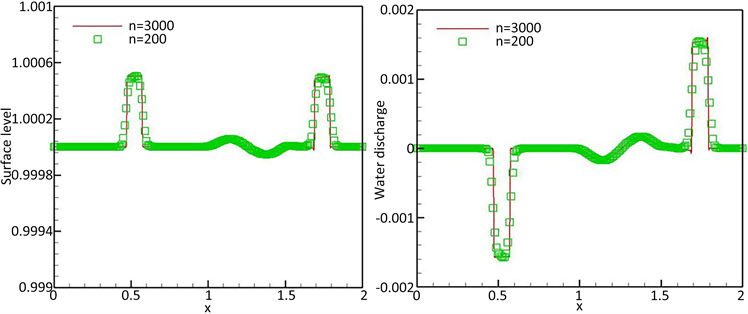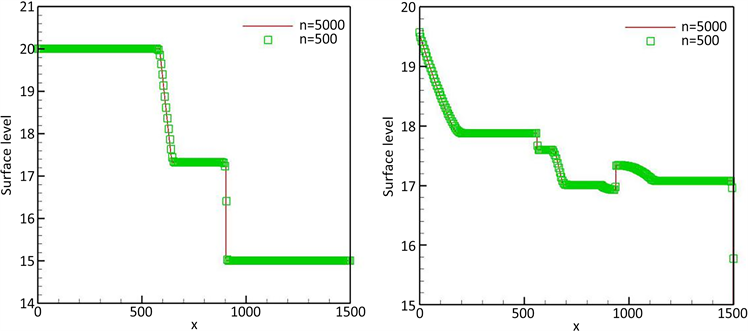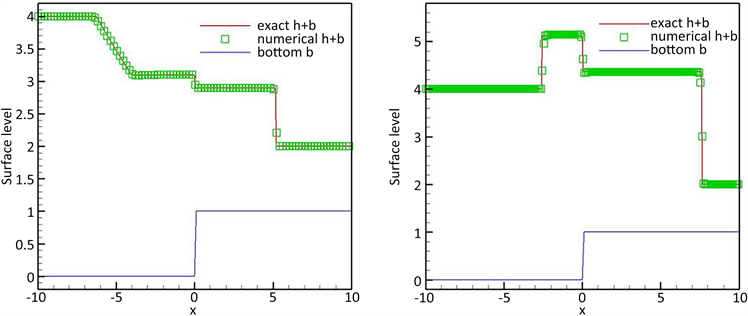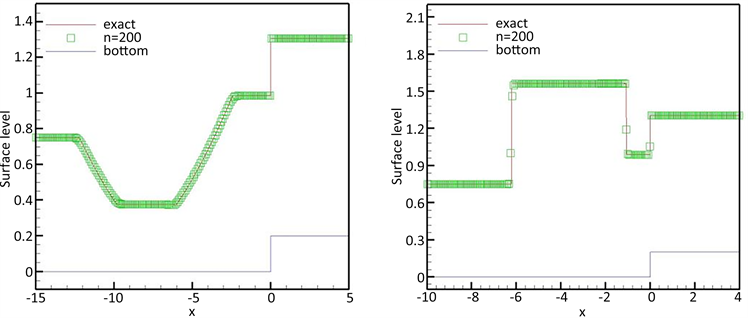1. 引言
浅水方程(SWEs)被广泛应用于模拟浅水流体(如河流、海岸流、湖泊流、潮汐等)。其一维(1-D)形式为
(1)
其中
,
和
分别为流体的高度和深度平均速度。这里,
表示底部地形,
为重力常数。其中,
表示由于水体底部不平所造成的几何源项。
特别是方程组(1)保持了以下湖泊静止稳态
(2)
实际上,由于方程组(1)的高度非线性,对其进行理论分析非常困难。因此,高阶格式数值求解是求解这些问题的有效方法,在计算流体力学领域引起了广泛关注 [1] [2] [3] 。之后出现了很多研究(1)的高阶格式,其中具有代表性的SWEs格式主要有:中心迎风格式 [4] 、加权本质非振荡(WENO)格式 [5] - [14] 、中心格式 [15] [16] [17] [18] 、龙格库塔间断伽辽金(RKDG)方法 [19] [20] [21] 、ADER (时空任意导数)格式 [22] [23] 、Godunov型方法 [24] [25] 、DG谱元方法 [26] 、中心逆风格式 [27] [28] 、ADER-DG方法 [29] 。中心迎风格式是扩展半离散的中信格式且注意源项的离散化;经过多人研究的WENO格式能够保持其原始的高阶精度和一般解的基本非振荡特性;RKDG方法完全保留了等温流体静力状态的W-B特征,用大量示例展示了W-B功能、高阶精度和良好的分辨率;ADER格式具有源项的双曲系统在空间和时间上的高精度,实现并测试了在空间和时间上精度高达五阶的方案。
本文是基于方程组(1)的精确解可能不存在的原因而从分布意义上寻找弱解,但弱解可能不是唯一的。因此,添加一个熵条件来确定一个物理相关的解。事实上,熵条件在所有可能的弱解中筛选熵解起着重要作用。
定义1 (熵函数 [30] )凸函数
被称为方程组(1)的熵函数,如果存在满足等式的熵通量
使得
(3)
其中
为熵变量。相应地,我们称
为熵对。
对于给定的熵对
,将(1)的两端乘以
,(1)的光滑解满足下面的熵等式
(4)
然而,上述等式(4)在出现间断解的情况下不再成立。特别地,方程组(1)的弱解
被称为熵解 [30] ,如果存在熵不等式
(5)
对于给定的熵对
在分布的框架下是成立的。
通常,熵等式(4)和熵不等式(5)都被称为熵条件,这在理论上对(1)等双曲平衡律的适定性起着重要作用。根据(5)满足离散熵不等式的格式也被称为熵稳定(ES)格式。近年来,对于SWEs,具有高鲁棒性的ES格式得到了广泛关注,如DG谱元方法 [31] 、节点DG方法 [32] 、RKDG方法 [33] [34] 、有限差分(FD)格式 [35] [36] 。
本文的主要目的是为中小企业开发一个高阶ES FD格式。首先,我们提出了一种二阶熵守恒(EC)格式,该格式满足熵等式,采用适当的底部地形离散化和两点EC通量。然后,以获得的二阶EC格式为构成元素,得到相应的高阶EC格式。此外,该格式完全保持了湖泊静止稳态,具有well-balanced性质(WB)。
但是,EC格式可能在间断附近引起伪振荡。为了克服这一缺点,我们根据熵变量利用WENO重构构造了合适的耗散项,并将其添加到EC通量中,实现了高阶ES格式。所提出的ES格式满足半离散形式的熵不等式。最后,采用龙格–库塔方法对半离散ES格式进行时间迭代。
本文的内容组织如下:在第二节中,我们提出了一种适用于一维SWEs的EC FD格式。随后,我们在第3节中对提出的格式进行了W-B分析。在第4节中,我们实验了几个经典的例子来证明当前格式的性质。最后,我们在第5节中得出了一些结论。
2. 一维EC格式的构造
为方便起见,方程组(1)有如下等价形式
(6)
其中
其中,对于一维SWEs(6),我们取总能量
作为数学熵函数 [30] [36] 与
作为熵变量。相应地,根据(3)的一致条件熵通量为
此外,我们假定
作为熵势。
首先,我们将空间域划分为以
为网格节点的均匀网格,并以
为空间步长。(6)的FD格式为
(7)
其中,符号
表示
在点
处的平均值。此外,这里使用数值通量
来近似
处的物理通量
。然后,我们着重构造数值通量
。
特别地,式(7)的解满足以下半离散熵等式
(8)
那么格式(7)被称为EC格式。这里需要数值熵通量
与给定熵通量q保持一致,则数值熵通量
即为EC通量。实际上,式(8)根据等式(4)表示离散状态。
下面引理给出了格式(7)为EC的充分条件,以及源项离散化。
引理1 给定格式(7)称为EC,是二阶格式,条件是数值通量
在(7)中满足
(9)
其中
。(8)中的数值熵通量
为
(10)
证明 (7)两端左乘
得到
然后有
这里
和
已应用于上述第一个方程;充分条件(9)以及等式
已用于第二个和第三个。因此,格式(7)用
对(8)进行EC模拟。
此外,(7)中的源项离散化采用了二阶中心差分。此外,从 [37] 开始对通量梯度的离散也是二阶精确的。因此,格式(7)最终具有二阶精度。
接下来,我们给出了满足充分条件(9)的EC通量。
定理2 对于1-d SWES (1),数值通量
(11)
为EC通量,与(1)中的物理通量
兼容。
证明 在这里,重点在于我们使用下面的恒等式
并应用下面跳跃的等价形式
然后将上述表达式代入(9),得到
然后,我们得到下面的恒等式
通过比较同一跳系数,得到
因此,我们最终得到(11)中的数值通量
。
备注1 此外,令
在(11)中可得
因此,(11)中的EC通量
与物理通量
是相一致的。
3. W-B性质分析
在这里,我们总结下该格式的W-B性质,并提出下面的定理。
定理3. EC通量为(11)的格式(7)为W-B,并保持湖静止稳态(2),即(7)的解满足
和
其中
。
证明 首先,在
的假设下,由(11)可知
,由(7)可知
。
其次,我们有
(12)
其中等式
已用于第二个等式。另外,
导致最后一个等式,因为
。因此,该格式即为W-B的。
4. 数值结果
在本节中,我们将通过计算不同算例来测试所提出的熵稳定方法的性能。我们在整个计算过程中取重力常数g为9.812,为了保持数值稳定性取
。另外,时间离散采用三阶Runge-Kutta方式,
(13)
 ε = 0.2
ε = 0.2 ε = 0.001
ε = 0.001
Figure 1. Surface level h + b (left) and water discharge hu (right) at t = 0.2
图1. t = 0.2时的水体表面h + b (左)和出水hu (右)
4.1. 定常水流的扰动问题
这个例子被用来测试该格式捕捉小扰动的能力。初始条件为
水体表面为
的凹凸状
随着时间的推移,初始扰动分解为两个不同方向的脉冲,如图1所示。这两种类型的脉冲都被很好地分辨出来,并且与文献 [7] 中的脉冲很好地吻合。
4.2. 一个矩形凸起上的溃坝问题
我们模拟一个溃坝问题 [5] [7] [12] [38] ,并使用以下初始条件
底部为矩形
图2分别为t = 15和t = 60时的水体表面。从图2可以看出,该格式得到了较好的结果,与 [5] [7] [12] [38] 中的参考解吻合较好。

Figure 2. Surface level h + b at t = 15 (left) and t = 60 (right)
图2. t = 15 (左)和t = 60 (右)时的表面h + b
4.3. 过驼峰的一个平稳流
进一步,我们用一个广泛使用的例子 [39] 验证了该格式。实际上,本例基于以下初始数据对跨临界流和次临界流进行了建模
底部区域为驼峰
随后,我们在计算区域的两端实施不同的边界条件。此外,我们还展示了从 [40] 得到的精确解,以提供更好的比较。
• A:无激波的跨临界流动
上游边界的排水量hu = 1.53,下游边界的水深h = 0.66。
• B:带激波的跨临界流
上游边界和下游边界分别施加排水量hu = 0.18和水深h = 0.33。
• C:亚临界流
在上游边界施加流量hu = 4.42,在下游边界施加水深h = 2。
图3给出了上述三种情况的计算结果,表明数值计算结果与实际情况吻合较好。
 A B C
A B C
Figure 3. Surface level h + b at t = 200
图3. t = 200时,表面h + b
4.4. Riemann问题
这里,我们用数值方法模拟了一个底部地形为台阶上的断裂例子。
• A
此外,我们使用下面的初始数据实现了一个来自 [41] 的示例
以及一个台阶一样的底部
随着时间的推移,这个例子产生了一个向左移动的稀薄层和一个向右移动的激波。
• B
初始数据为
基于上面同样的底部。随着时间的推移,这个例子出现了两个向不同方向移动的冲击。
• C
本算例来自 [42] ,初始条件为
基于以下底部
 A B
A B C D
C D
Figure 4. Surface level h + b at t = 1
图4. t = 1时的表面h + b
• D
初始数据为
其中,底部地形与情形C一致
图4显示了上述四个例子与精确解的对比结果,清楚地表明了良好的一致性。
5. 结论
本文提出了一种适用于底层地形的一维ES FD格式。首先,我们构造了满足给定熵对的离散熵恒等的二阶EC FD格式,同时保持湖泊静止稳态;关键的思想是同时匹配通量梯度和几何源项。然而,EC格式可能在间断附近产生伪振荡,因此我们在EC通量中加入适当的耗散项。本文采用基于尺度熵变量的WENO重构方法构建耗散项。
最后,我们采用龙格–库塔方式进行时间离散化。此外,大量的实例表明,所提出的格式是W-B,具有较高的精度,并能很好地解决小扰动。
基金项目
本研究的作者钱守国得到了山东省自然科学基金资助项目(ZR2021MA072)的支持。
NOTES
*通讯作者。